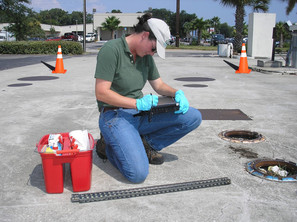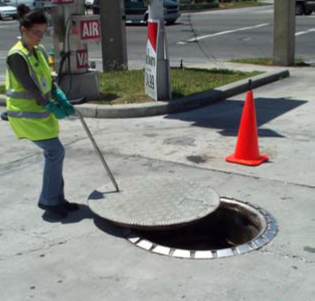Financial Responsibility
A facility owner is required to obtain and maintain financial assurance and demonstrate that it has the ability to pay for the cleanup of a discharge should one happen at the facility. Financial responsibility can be demonstrated by the owner, or the facility operator, tank owner or tank operator on behalf of the facility owner.
The required amounts and allowable mechanisms of coverage are stated in the Environmental Protection Agency's (EPA) reference guidelines. Documentation of financial assurance must be maintained to meet the requirements of Rules 62‑761 and 62‑762, F.A.C. Completed selected parts of Form 62-761.900(3) - Financial Mechanisms for Storage Tanks - must be used to meet these financial responsibility requirements. More information about Storage Tank Financial Assurance can be found here.
Integrity Testing
The integrity of secondary containment systems and interstitial spaces is required to be tested at the time of installation and again on regular intervals. The routine testing of these components, either annually or every three years, has been required since 2018. Testing procedures should follow manufacturer recommendations; however, if the manufacturer does not provide testing instructions then a tester should follow the instructions found in PEI/RP-1200 or PEI/RP-100.
Recently the American Society for Testing and Materials (ASTM) published an alternative integrity testing method for spill bucket and sump testing. EPA regulation requires testing to be done by liquid, pressure or vacuum. Although this method could be beneficial to the maintenance of the tank system, the ASTM E3225-20 is visually based and does not meet the EPA requirements nor will it fulfill the DEP requirements for integrity testing.
The rule update further clarified below-grade components to be those that are in contact with the soil or over surface waters of the state. From October 2019 forward all secondary containment components will need to be routinely tested including piping and dispenser sumps over surface waters of the state. Marinas and other facilities with regulated components over the water will need to have those tested by July 9, 2020, and every three years thereafter.

Tank Closures
A storage tank system that requires repair but can’t be repaired within 90 days will need to be taken out-of-service. If the system can’t be repaired within 365 days from being placed out-of-service, it will need to be permanently closed.
Placing a Tank Out-of-Service - Registration Requirements
Storage tanks that are placed out-of-service need to have their status updated with Tank Registration. This can be done by completing a Storage Tank Registration Form and emailing it to tankregistration@FloridaDEP.gov or mailed to:
DEP, DWM Waste Registration, MS 4525,
2600 Blairstone Road, Tallahassee, FL 32399.
Registration updates and changes in facility contact information can also be made online through the ESSA Portal.
Please note that financial responsibility is still required for out-of-service storage tanks. Before placing your tank in the out-of-service status be sure to verify that the tank will still be covered under your financial responsibility as many insurance companies are not providing coverage for tanks that are not in use. |
Incidents
All incidents must be investigated within 24 hours of discovery and an Incident Notification Form submitted to the appropriate county inspector within 72 hours of discovery. The incident investigation should be completed and either a Discharge Report Form, or a written explanation why the incident was not a discharge, must be submitted to the county inspector within 14 days of the date of discovery.
Recent rule updates added conditions that are now recognized as incidents requiring investigation and Notification for both ASTs and USTs.
• An alarm indicating liquid in a dispenser, piping or containment sump
• Any part of the tank system, dispenser, pipe, valve, pump or portion of the system that contains regulated substances that shows uncontrolled pitting corrosion, structural damage, or leakage

Notification of Discharges
In addition to incident reporting requirements details above, if a discharge happens at your facility, whether it’s from a UST or an AST, the release must be reported to the State Watch Office at 800-320-0519 within 24 hours of discovery. The State Watch Office is monitored 24 hours a day, seven days a week, to record, analyze and share information with Federal, State and County partners for appropriate response.
In addition to notifying the State Watch office, a Public Notice of Pollution must also be issued within 24 hours of discovery. The preferred method for reporting a Public Notice of Pollution is to submit the Notice online. You may also report via e-mail using the Pollution Notice Form and e-mailing it to pollution.notice@dep.state.fl.us.
When completing the State Watch Report or Public Notice of Pollution, please be prepared to provide the following information:
• Name and address of the facility
• DEP facility ID number
• Name, title and phone number of the person making the report
• Date, time and duration of the release
• Synopsis of the situation
• Substance released, and estimated quantity released
• Response actions and estimated quantity of the substance that has been recovered
• Cause and source of the release
• Location of the release (tank, dispenser, sump, piping, etc.)
• Where the substance was released (pavement, soil, water, stormwater pond, etc.)
• Whether the released substance has moved off the facility property
System Requirements
Effective October 17, 2019, a primary overfill device must be designated for all ASTs and USTs. The designated overfill device must be listed on the department’s EQ List. Some tanks may have more than one overfill device, but only the primary designated device needs to be tested annually for operability.
ASTs with a capacity of 15,000 gallons or less, and USTs with a capacity of 2,000 gallons or less, may use calibrated stick measurements for their overfill protection as long as the following conditions are met:
• There is an inches-to-gallons tank chart posted at the tank fill area or readily available to the delivery driver
• Storage tanks are not filled with a mated tight fill adapter connection during delivery
• Tanks are not filled beyond 95% capacity
Dispensers associated with shop fabricated ASTs are required to have a dispenser sump unless the dispenser is already located in an impervious dike field area, mounted directly on top of the storage tank or doesn’t have any underground essential piping. However, dispensers located over surface waters of the state are required to have a dispenser sump. |